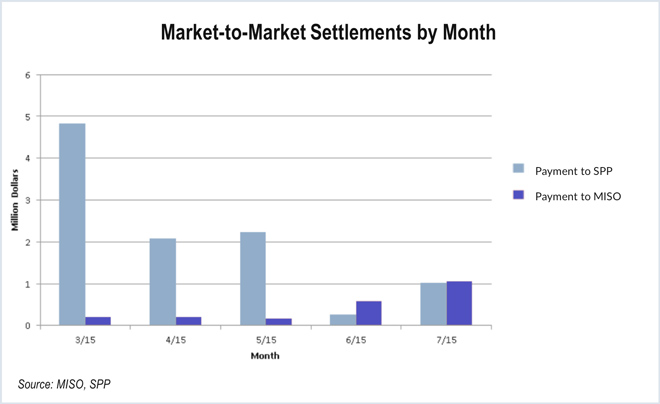By Tom Kleckner
SPP and MISO met last week with their stakeholders to review the first five months of market-to-market (M2M) operations between the two RTOs, saying that while the process is off to a good start, there’s much room for improvement.
“On the whole, market-to-market is working well. It’s a more efficient solution when both markets have control of the congested flowgate,” said David Kelley, SPP’s director of interregional relations. “We’re just talking about design flaws in the overall process … specific instances where we don’t believe it’s working as it should.”
“The price convergence is not happening on some flowgates,” said MISO’s Ron Arness, senior manager of seams administration. “We need to improve that.”
M2M is intended to improve price convergence on flowgates along the RTOs’ seams: The RTOs compensate each other for redispatching generation to reduce congestion in a way that reduces overall costs.
‘Philosophical Discussion’ Needed
The two RTOS have identified nine issues that need a “philosophical discussion,” Kelley said. They include developing criteria for M2M’s usage when one or both RTOs do not have effective control of a flowgate, leading to oscillation — when one market has significantly more control over a flowgate than the other market, resulting in the constraint’s unbinding and reloading too quickly during the exchange of shadow prices — and price separation. They also have called for criteria to recalculate firm-flow entitlements (FFE) due to modeling issues or outages.
SPP has a separate concern over the differences in the RTOs’ settlement billing cycles, which ends up with SPP floating dollars for several days while trying to remain revenue neutral. Arness said those discussions will involve SPP’s and MISO’s upper management.
SPP maintains the oscillations have overloaded flowgates and led to higher shadow prices for transmission constraints — the marginal costs of reducing a constraint per megawatt of flow.
“SPP was able to manage constraints just fine before market-to-market, and we didn’t have oscillation,” Kelley said. “We believe changes can be made, but the [joint operating agreement] is flexible enough to where we can do that.”
Through July 27, MISO has sent $10.4 million to SPP to compensate for congestion costs, with SPP sending MISO $2.2 million. The two RTOs have experienced 243 M2M events — when the RTOs exchange messages concerning a flowgate needing relief — totaling 1,024 hours.
SPP and MISO have 135 permanent flowgates and 45 temporary flowgates between the two. MISO’s footprint accounts for the bulk of those flowgates, with 89 permanent and 13 temporary.
The two RTOs hold weekly review calls to approve M2M events. SPP and MISO review real-time operations of the events and the data-sharing processes to ensure they are able to correctly perform M2M settlements. The two parties must reach agreement before performing any settlements or adjustments.
Monitors’ Perspective
SPP’s and MISO’s market monitors took turns presenting their views of M2M’s performance so far.
SPP’s Market Monitoring Unit noted effective M2M should lower shadow prices and the length of congestion events but that it has not yet looked at enough data for most constraints. It said data for the first months showed no major unexpected M2M effect on prices, but those impacts vary by constraint.
The MMU also said SPP and MISO calculate their shadow prices differently and that M2M on some flowgates can have a significant impact on prices for a large portion of the SPP market, especially in Nebraska and western Kansas.
MISO’s Independent Market Monitor (IMM) said M2M coordination has been a “net benefit” in MISO by reducing congestion costs. The IMM did note, however, a number of startup issues that were “isolated and … not ongoing.”
The IMM said the two RTOs have used work-arounds when normal coordination did not lead to efficient results. It said while some work-arounds have been expedient, they “have not been ideal” and called for improved coordination procedures and possible JOA revisions.
“In particular,” the IMM said, “the current JOA may assign the monitoring responsibility for a flowgate to the RTO that has less or ineffective relief capability. In theory, this would not preclude efficient coordination. In practice, timing and coordination issues cause this to result in constraint oscillation, inefficiencies that are difficult to resolve and higher costs.”




